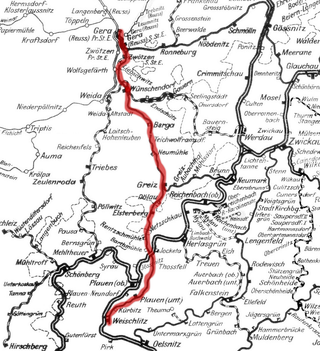
Thuringia, officially the Free State of Thuringia, is a state of central Germany, covering 16,171 square kilometres (6,244 sq mi), the sixth smallest of the sixteen German states. It has a population of about 2.1 million.
Altenburger Land is a district in Thuringia, Germany. It is bounded by the district of Greiz, the Burgenlandkreis (Saxony-Anhalt), and the districts Leipzig, Mittelsachsen and Zwickau in Saxony. The district is a member of the Central German Metropolitan Region.

Gera is a city in the German state of Thuringia. With around 93,000 inhabitants, it is the third-largest city in Thuringia after Erfurt and Jena as well as the easternmost city of the Thüringer Städtekette, an almost straight string of cities consisting of the six largest Thuringian cities from Eisenach in the west, via Gotha, Erfurt, Weimar and Jena to Gera in the east. Gera is the largest city in the Vogtland, and one of its historical capitals along with Plauen, Greiz and Weida. The city lies in the East Thuringian Hill Country, in the wide valley of the White Elster, between Greiz (upstream) and Leipzig (downstream). Gera is located in the Central German Metropolitan Region, approximately 60 kilometres south of Saxony's largest city of Leipzig, 80 km east of Thuringia's capital Erfurt, 120 km west of Saxony's capital Dresden and 90 km north of Bavaria's city of Hof (Saale).
Greiz is a Kreis (district) in the east of Thuringia, Germany. Neighboring districts are Saale-Holzland, Saale-Orla, district-free city Gera, the Burgenlandkreis in Saxony-Anhalt, Altenburger Land, and the two Saxon districts Zwickau and Vogtlandkreis.

The White Elster is a 257-kilometre (160 mi) long river in central Europe, right tributary of the Saale. Its source is in the westernmost part of the Czech Republic, in the territory of Hazlov. After a few kilometres, it flows into eastern Germany where it cuts through the Vogtland in a "deep and picturesque valley". In Germany it flows through the states of Saxony, Thuringia and Saxony-Anhalt. The White Elster flows through the cities of Plauen, Greiz, Gera, Zeitz, Pegau and Leipzig, and into the river Saale in Halle.

The German Emperor was the official title of the head of state and hereditary ruler of the German Empire. A specifically chosen term, it was introduced with the 1 January 1871 constitution and lasted until the official abdication of Wilhelm II on 9 November 1918. The Holy Roman Emperor is sometimes also called "German Emperor" when the historical context is clear, as derived from the Holy Roman Empire's official name of "Holy Roman Empire of the German Nation" from 1512.

Schloss Altenstein is a schloss, or palace, upon a rocky hill on the south-western slope of the Thuringian Forest, not far from Eisenach, Thuringia, Germany. It was the summer residence of the Dukes of Saxe-Meiningen, and is surrounded by 160 hectares of English landscape garden, which contain, among other objects of interest, a cavern 300 metres long, through which flows a large and rapid stream.

Heidecksburg is a Baroque palace in Rudolstadt, Thuringia, and served as the residence of the princes to Schwarzburg-Rudolstadt. It is located prominently approximately 60 m above the old town. After a fire in 1735 and its reconstruction, it has remained intact, including during World War II.
Wünschendorf/Elster is a Verwaltungsgemeinschaft in the district of Greiz, in Thuringia, Germany. The seat of the Verwaltungsgemeinschaft is in Wünschendorf/Elster.

Crossen an der Elster is a village and municipality in the district Saale-Holzland, in Thuringia, Germany. The White_Elster is the name of the small river which flows through the municipality, so 'Crossen on the Elster' would be the English equivalent.
Heideland-Elstertal-Schkölen is a Verwaltungsgemeinschaft in the district Saale-Holzland, in Thuringia, Germany. The seat of the Verwaltungsgemeinschaft is in Crossen an der Elster.
Leipzig is a district (Kreis) in the Free State of Saxony, Germany. It is named after the city Leipzig, which is partly surrounded by the district, but not part of it. It borders the state Saxony-Anhalt, the urban district Leipzig, the districts Nordsachsen and Mittelsachsen, and the state Thuringia.
Beverley is an unincorporated community in Saskatchewan.

The Goethe-Nationalmuseum is a museum devoted to the German author Johann Wolfgang von Goethe, in the town of Weimar in Germany. Originally comprising the Goethe House, where Goethe lived intermittently for 50 years from 1782 to 1832, the museum was founded on 8 August 1885 as a result of the will of Goethe's last living heir, his grandson Walther von Goethe, who left the Goethe House to the state.

The Gera Süd–Weischlitz railway is a main railway line in the German federal states of Thuringia and Saxony, which was originally built and operated by the Saxon-Thuringian Railway Company. It runs in the valley of the White Elster from Gera via Greiz and Plauen to Weischlitz.

Schloss Moritzburg is a Schloss (palace) in Zeitz on the White Elster in the Burgenlandkreis in Saxony-Anhalt. The present baroque building dates from the 17th century and was previously a royal palace and fortified seat of a bishop. Zeitz Cathedral is also located on the site.

The Erfurter Bahn is a railway company and public transit system serving the city of Erfurt, the capital of Thuringia, Germany. Erfurter Bahn is a wholly owned subsidiary of the Erfurt city council, and Süd-Thüringen-Bahn, operating between Erfurt and Meiningen, is a subsidiary of the former. Services are operated by Regio-Shuttle RS1 and Bombardier Itino trains.
The Werdau–Mehltheuer railway is a branch line in the German states of Saxony and Thuringia, originally built and operated by the Royal Saxon State Railways. The section from Werdau to Weida via Wünschendorf is now closed. The section between Weida and Mehltheuer is part of the Gera–Hof link.
Saale-Holzland-Kreis II is an electoral constituency represented in the Landtag of Thuringia. It elects one member via first-past-the-post voting. Under the current constituency numbering system, it is designated as constituency 36. It covers the northern part of Saale-Holzland-Kreis.

Schloss Friedrichsthal is an 18th-century palace located in Gotha, Thuringia, Germany. It is located east of Friedenstein Palace.












